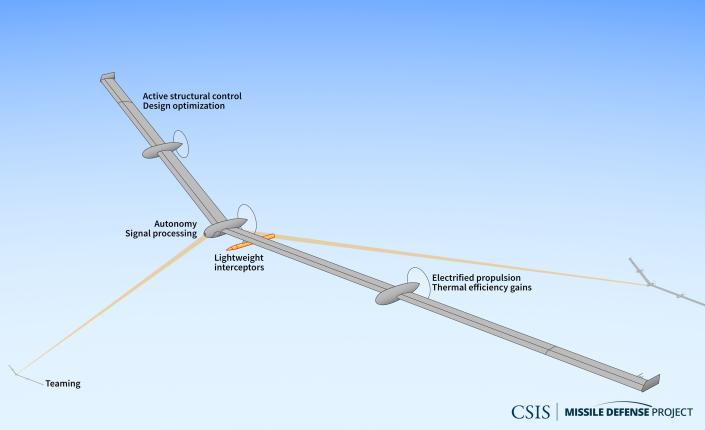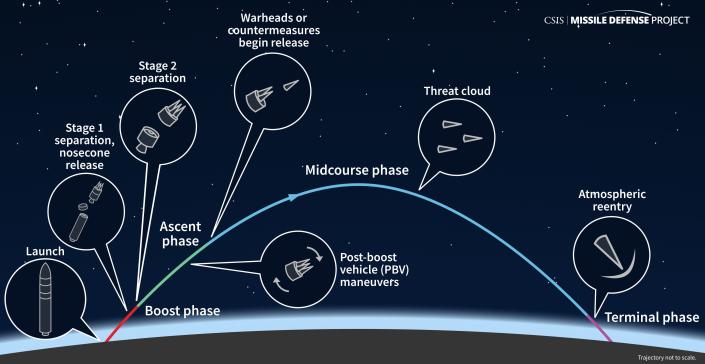Intercepting missiles early — in their boost phase — is one of the oldest aspirations of the U.S. missile defense enterprise.
By striking missiles before they can release decoys and multiple warheads, a defender can expend fewer interceptors against an incoming missile attack.
Despite these obvious benefits and several past efforts, such a system has yet to mature past research and development. While some older analyses concluded boost-phase intercept is unworkable, new technologies may be making the approach increasingly viable.
With North Korea and Iran introducing more capable and maneuverable missile systems, the United States should reexamine boost-phase intercept options for improving U.S. homeland missile defense.
The desirability of intercepting a missile early in its flight has long been recognized. In the short time when a missile is boosting into space, it has yet to deploy countermeasures, multiple warheads, or maneuvering payloads which can stress traditional missile defenses.


Yet boost-phase defense has tremendous challenges. Boost phases are short, usually no longer than 300 seconds. This short window of opportunity drives very high system requirements, including proximity to the threat, low-latency sensors and communications systems, and fast interceptors.
There are now several advancing technology areas that, if harnessed, could make earlier intercepts more tractable. The Center for Strategic and International Studies’ Missile Defense Project recently released a new study highlighting advancements in sensors, space launch, directed energy, and remotely piloted aircraft that are upending traditional assumptions about the feasibility of boost-phase defense.
For example, new sensor technologies like gallium nitride-based radar could reduce the timeline for detecting a boosting ballistic missile. The reduced mass of such systems could allow basing on a greater variety of platforms, including airborne platforms, allowing earlier detection of a target.
At the same time, advances in infrared sensor performance and image processing might further compress timelines for detecting enemy missile launches. Delays in sensing a boosting missile have played an outsized role in a boost-phase system’s performance. Even small reductions in detection and tracking delays could yield significant performance improvements.
Likewise, the dramatic declines in the costs of satellite manufacturing and launch might allow for space-based sensors or interceptors. And promising advances in laser scaling could revive the possibility of a non-kinetic system, with its attendant advantages for handling larger numbers of threats.


In the near term, advancements in long-endurance remotely piloted aircraft might put a limited boost-phase defense layer within reach, offering a persistent platform for sensors and interceptors. While advancements in UAS control, propulsion, and aerostructures offer attractive headroom for future sensor platforms, existing UAS, equipped with an appropriately fast interceptor, could likely provide some defense against North Korean missile threats. Intercontinental ballistic missile trajectories from Iran to North America are more challenging, but early intercepts may be possible from allied airspace with very fast interceptors.
Even as the technology comes into its own, questions remain about the strategic need to invest in U.S. homeland missile defense. Recognizing the growing complexity of missile threats to the homeland, the United States plans to field the Next Generation Interceptor in 2028.
However, U.S. missile defense efforts have long envisioned a layered approach, and for good reason. No single system is perfect, and a boost-phase defense layer based on appropriately mature technologies could significantly contribute to U.S. homeland missile defense.
Adding a new North Korea-centric missile defense layer could receive scrutiny when the United States is shifting its strategic focus from rogue states and counterterrorism toward great power competition. Even as priorities shift, homeland missile defense remains a backstop for the United States’ strategic commitment in the Indo-Pacific region.
The threats that prompted the United States to invest in homeland missile defense are still present and growing. The United States can ill afford to be vulnerable to coercion by states like North Korea if it intends to compete with peer competitors like China. As Russia’s invasion of Ukraine has made clear, U.S. vulnerability to nuclear blackmail emboldens authoritarian governments and constrains U.S. options in dealing with their aggression.
The feasibility of early intercept concepts is among the oldest debates within the strategic defense community. But people’s perceptions of an issue can stagnate, laden with old baggage and citations. Technological capability, in the meantime, has advanced. As such, there are assumptions to reexamine and possible solutions in sight.
Ian Williams is a fellow in the International Security Program at the Center for Strategic and International Studies and deputy director of the CSIS Missile Defense Project. Masao Dahlgren is a research associate with the CSIS Missile Defense Project. They are the lead authors of the CSIS report Boost-Phase Missile Defense: Interrogating the Assumptions.




